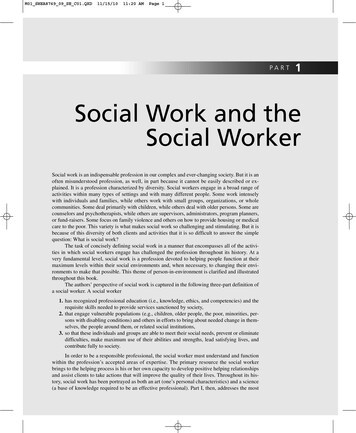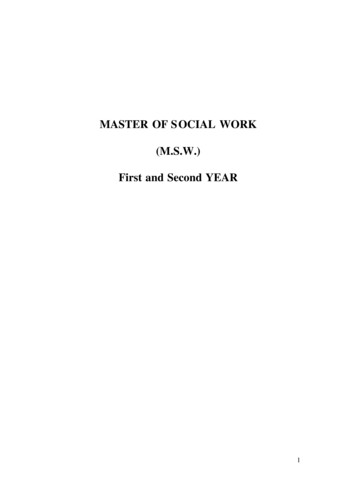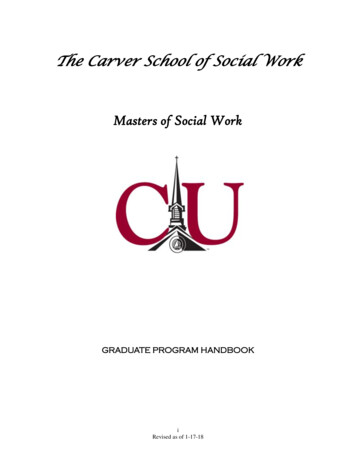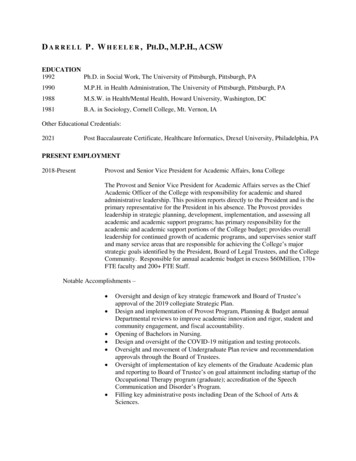
Transcription
M01 SHEA8769 09 SE C01.QXD11/15/1011:20 AMPage 1PA R T1Social Work and theSocial WorkerSocial work is an indispensable profession in our complex and ever-changing society. But it is anoften misunderstood profession, as well, in part because it cannot be easily described or explained. It is a profession characterized by diversity. Social workers engage in a broad range ofactivities within many types of settings and with many different people. Some work intenselywith individuals and families, while others work with small groups, organizations, or wholecommunities. Some deal primarily with children, while others deal with older persons. Some arecounselors and psychotherapists, while others are supervisors, administrators, program planners,or fund-raisers. Some focus on family violence and others on how to provide housing or medicalcare to the poor. This variety is what makes social work so challenging and stimulating. But it isbecause of this diversity of both clients and activities that it is so difficult to answer the simplequestion: What is social work?The task of concisely defining social work in a manner that encompasses all of the activities in which social workers engage has challenged the profession throughout its history. At avery fundamental level, social work is a profession devoted to helping people function at theirmaximum levels within their social environments and, when necessary, to changing their environments to make that possible. This theme of person-in-environment is clarified and illustratedthroughout this book.The authors’ perspective of social work is captured in the following three-part definition ofa social worker. A social worker1. has recognized professional education (i.e., knowledge, ethics, and competencies) and therequisite skills needed to provide services sanctioned by society,2. that engage vulnerable populations (e.g., children, older people, the poor, minorities, persons with disabling conditions) and others in efforts to bring about needed change in themselves, the people around them, or related social institutions,3. so that these individuals and groups are able to meet their social needs, prevent or eliminatedifficulties, make maximum use of their abilities and strengths, lead satisfying lives, andcontribute fully to society.In order to be a responsible professional, the social worker must understand and functionwithin the profession’s accepted areas of expertise. The primary resource the social workerbrings to the helping process is his or her own capacity to develop positive helping relationshipsand assist clients to take actions that will improve the quality of their lives. Throughout its history, social work has been portrayed as both an art (one’s personal characteristics) and a science(a base of knowledge required to be an effective professional). Part I, then, addresses the most
M01 SHEA8769 09 SE C01.QXD211/15/1011:20 AMPage 2Part 1 Social Work and the Social Workerfundamental elements of social work practice—the blending of the person and the profession—in order to most effectively assist individuals, families or other households, small groups, organizations, and communities as they work to prevent or resolve the complex social problemsthat arise in their daily lives.
M01 SHEA8769 09 SE C01.QXD11/15/1011:20 AMPage 3CHAPTER1The Domain of the SocialWork ProfessionWhen a person sets out to help others, especially those most vulnerable to social problems, he orshe assumes a serious responsibility. The responsible professional must practice within his or herprofessional domain (i.e., the profession’s area of expertise, or its “professional turf”) if clientsare to receive the services that the profession is sanctioned to provide. Indeed, professionalhelpers can harm clients if their activities extend beyond their professional boundaries becausethese boundaries establish the content of the profession’s formal education and identify the services its members are best prepared to deliver.This book is concerned with the profession of social work and how social workers assistpeople in addressing a variety of different issues that confront them. Social work is, indeed, a curious name for a profession. In times that emphasize image over substance, it is clearly a title thatlacks pizzazz. In fact, the use of the word work makes it sound burdensome and boring. It is atitle that many social workers have wished they could change, possibly without understandingwhere it came from in the first place.The title is attributed to Jeffrey Brackett (1860–1949) who served for nearly 30 years onthe Massachusetts Board of Charities and later became the first director of what is now theSimmons College School of Social Work. In the early 1900s, Brackett argued that the wordsocial should be part of this developing profession’s title because it depicts the focus on people’sinteractions with important forces that shape their lives, such as family members, friends, or amyriad of other factors, including their relevant cultural or ethnic group, school, job, neighborhood, community, and so on. He added the word work to differentiate professional practice fromwhat he considered the often misguided and self-serving philanthropic activity of wealthy volunteers. He believed including the word work in the profession’s title emphasized that its activitieswere to be orderly, responsible, and disciplined—not something to be engaged in by someoneunprepared for these tasks.Social work is an accurate title for a profession that applies helping techniques in adisciplined manner to address social problems. During the years since Brackett convinced earlyhelping services providers to accept this title, the domain of social work has expanded and itsapproach has been reshaped by the increasing knowledge generated by the social and behavioralsciences. Yet the title continues to describe this profession’s central focus today.THE SOCIAL WORK DOMAINIt is important for the social worker to carefully examine the domain of social work (i.e., to understand its purpose, focus, scope, and sanction). This is especially important for students because educational programs divide the study of social work into units, or courses, and this canlead to familiarity with the parts without necessarily understanding the whole.3
M01 SHEA8769 09 SE C01.QXD411/15/1011:20 AMPage 4Part 1 Social Work and the Social WorkerOne reason for understanding of the social work domain is to help guard againstprofessional drift: the neglect of the profession’s traditional purpose and functions in favor ofactivities associated with another professional discipline. This happens most often in clinical settings when social workers align themselves too closely with models and theories used in medicine, psychology, and other disciplines, which tend to minimize social policy and social justiceissues. These practitioners may come to view themselves as psychotherapists first and socialworkers second—or perhaps not as social workers at all. Professional drift is also seen amongadministrators and managers who were trained as social workers but are identified primarily withtheir specific organizations rather than the social work profession. When professional drift occurs, it is a disservice to one’s clients, employing social agency, and community for it diminishesthe commitment, perspective, and competencies unique to social work.A precise and generally agreed-upon understanding of the boundaries that mark the severalhelping professions does not exist. Different disciplines (e.g., social work, clinical psychology,school counseling, and marriage and family therapy) have claimed their domains without collaboration or mutual agreement about where one profession ends and another begins or where theyappropriately overlap. This problem is further complicated by the fact that each state that choosesto license the practice of these professions is free to establish its own descriptions of professionalboundaries. It is important, therefore, to approach learning about social work’s domain with therecognition that boundaries between professions are sometimes blurred.Social Work’s PurposeAn understanding of the social work profession begins with a deep appreciation of humans associal beings. People are, indeed, social creatures. They depend on other people to help addressmany of their own needs. An individual’s growth and development requires the guidance, nurturing, and protection provided by others. And that person’s concept of self—and even his orher very survival, both physically and psychologically—is tied to the decisions and actions ofother people. It is this interconnectedness and interdependence of people and the power of social relationships that underpins a profession devoted to helping people improve the quality andeffectiveness of those interactions and relationships—in other words, to enhance their socialfunctioning.SOCIAL FUNCTIONING The concept of social functioning is a key to understanding theunique focus of social work and distinguishing social work from the other helping professions.Positive social functioning is a person’s ability to accomplish those tasks and activities necessary to meet his or her basic needs and perform his or her major social roles in the society. Basicneeds include such fundamental concerns as having food, shelter, and medical care, as well asbeing able to protect oneself from harm, finding acceptance and social support, having meaningand purpose in life, and so on. Major social roles include, for example, those of being a familymember, a parent, a spouse, a student, a patient, an employee, a neighbor, and a citizen. A person’s social roles change through his or her life, and expectations associated with these rolesdiffer somewhat depending on the person’s gender, ethnicity, culture, religion, occupation, andcommunity. (See Item 11.8 for more description of social role performance.) In sum, the concept of social functioning focuses on the match or fit between an individual’s capacities and actions and the demands, expectations, resources, and opportunities within his or her social andeconomic environment.Although the social work profession is concerned with the social functioning of all people,it has traditionally prioritized the needs of the most vulnerable members of society and thosewho experience social injustice, discrimination, and oppression. The most vulnerable in a societyare often young children, the frail elderly, persons living in poverty, persons with severe physicalor mental disabilities, persons who are gay or lesbian, or persons of minority ethnic/racialbackgrounds.
M01 SHEA8769 09 SE C01.QXD11/15/1011:20 AMPage 5Chapter 1 The Domain of the Social Work ProfessionTo carry out their commitment to improving people’s social functioning, social workersare involved in the activities of social care, social treatment, and social enhancement. Social carerefers to those actions and efforts designed to provide people in need with access to the basics oflife (e.g., food, shelter, protection from harm) and opportunities to meet their psychosocial needs(e.g., belonging, acceptance, and comfort in times of distress). In social care, the focus is on providing needed resources and/or on helping the client be as comfortable as possible in a difficultsituation that either cannot be changed or modified in the immediate future. Examples of socialcare would be efforts to address the needs and concerns of young children who must live in foster care, adults who have a serious and persistent mental illness, and persons who are dying.Social treatment involves actions designed to modify or correct an individual’s or afamily’s dysfunctional, problematic, or distressing patterns of thought, feeling, and behavior.In social treatment, the focus is primarily on facilitating individual or family change througheducation, counseling, or various forms of therapy. In many cases (e.g., work with children in foster care), the social worker may provide both social care and social treatment to the same client.A third form of intervention seeks to enhance, expand, or further develop the abilities andperformance of persons who are already functioning well. Social enhancement services emphasize growth and development of clients in a particular area of functioning without a “problem”having necessarily been identified. Some examples of enhancement-oriented services are youthand senior citizen recreation programs, well-baby clinics, marriage enrichment sessions, and jobtraining programs.IMPROVED SOCIAL CONDITIONS Social work’s second area of emphasis is on shaping andcreating environments that will be supportive and empowering. Underpinning this goal is one ofthe most fundamental social work values: a strong belief in the importance of achieving andmaintaining social justice. Social justice refers to fairness and moral rightness in how social institutions such as governments, corporations, and powerful groups recognize and support thebasic human rights of all people. A closely related belief of social workers is that the societyshould strive for economic justice (sometimes called distributive justice), which refers to fairnessin the apportioning and distribution of economic resources, opportunities, and burdens (e.g.,taxes). In other words, the economic resources of a society should be distributed (and redistributed) through structures of taxation and other economic mechanisms so that all people have opportunities for economic advancement and can meet their basic needs.Very often, political controversy has its origin in differing conceptions of what is truly fairand just and in differing beliefs on whether and how society should assume responsibility for addressing human needs and problems. Most social workers would argue that social and economicpolicies must recognize that all people have basic human rights—that is, claims on humanity atlarge, not because of individual achievement or by actions of government but simply by virtue ofone’s existence and one’s inherent worth and dignity. Among those basic human rights are thefollowing: The right to have the food, shelter, basic medical care, and essential social services necessary to maintain one’s life The right to be protected from abuse, exploitation, and oppression The right to work and earn a sufficient wage to secure basic resources and live with dignity The right to marry, to have a family, and to be with one’s family The right to a basic education The right to own property The right to be protected from avoidable harm and injury in the workplace The right to worship as one chooses—or not at all, if one chooses The right to privacy The right to associate with those one chooses The right to accurate information about one’s community and government The right to participate in and influence the decisions of one’s government5
M01 SHEA8769 09 SE C01.QXD611/15/1011:20 AMPage 6Part 1 Social Work and the Social WorkerSocial workers would also agree that along with rights come responsibilities. Rights andresponsibilities cannot exist without the other. Situations of injustice develop when people areconcerned only about their own rights and no longer possess a sense of responsibility for othersand society in general. To protect each right, there must be associated acts of responsibility. Forexample, in relation to the first three rights identified earlier: If a human has the right to be alive, then others have the responsibility to make sure that heor she has food, shelter, and essential medical care. If people have the right to be protected from abuse, exploitation, and oppression, then others have the responsibility to create social programs and take actions that will provide thisprotection when required. If a person has the right to work and earn a living, then others have the responsibilityto make sure that employment opportunities exist and that those who work are paid aliving wage.Social workers sometimes perform services to help achieve people’s rights; at othertimes, they serve as a voice for those whose rights are ignored or abused by calling on others torecognize the basic rights of all people and to act responsibly, with fairness and justice. When asocial worker is providing services to individuals, families, or groups, these changes would beconsidered environmental modifications. An example would be efforts by a school social workerto prepare students for the return of a former classmate who was badly scarred in an automobileaccident. Another example would be providing special training to a foster mother so thatshe can respond thoughtfully and constructively to a young foster child who exhibits inappropriate behaviors.Even when working with an organization or a community, a social worker may seek tomodify its wider environment. That may entail efforts to influence local decision-makers, businesses, political leaders, and governmental agencies so that they will be more supportive of theorganization’s mission or more responsive to a community’s needs and problems. Such macrolevel interventions may involve the worker in social research, social planning, and political action intended to develop and improve laws, social policies, institutions, and social systems sothat they will promote social and economic justice, expand opportunities for people, and improvethe everyday circumstances in which people live. Specific examples would be expanding theavailability of safe and affordable housing, creating incentives for businesses to hire people withdisabilities, amending laws so that they better prevent discrimination, and helping neighborhoodand community organizations become politically active in addressing the issues they face.Efforts to modify environments are sometimes labeled programs of prevention. Preventionconsists of those actions taken to eliminate social, economic, psychological, and other conditionsknown to cause or contribute to the formation of human problems. To be effective in prevention, social workers must be able to identify the specific factors and situations that contribute to the development of social problems and then select actions and activities that will reduce or eliminate their impact(see Item 12.13). Borrowing from the public health model, three levels of prevention can be identified:Level 1: Primary prevention. Actions intended to deter the problem from developingLevel 2: Secondary prevention. Actions intended to detect a problem at its early stagesand address it while it is still relatively easy to changeLevel 3: Tertiary prevention. Actions intended to address an already serious problem inways that keep it from growing even worse, causing additional damage, or spreading to othersSocial Work’s FocusSocial work is certainly not the only profession concerned with how individuals and familiesfunction, nor is it the only profession interested in social conditions and social problems.However, it is social work’s simultaneous focus on and attention to both the person and the person’s environment that makes social work unique among the various helping professions.
M01 SHEA8769 09 SE C01.QXD11/15/1011:20 AMPage 7Chapter 1 The Domain of the Social Work ProfessionOne’s environment may be either a support or a barrier to his or her effective social functioning. Because both the person and the environment are constantly changing, adaptations andadjustments must be ongoing. Social workers, therefore, must be especially vigilant regardingthose aspects of a person’s environment that are shaped by the social policies and programs thatmake up the social welfare system.The social work profession’s unique focus on the person-in-environment requires that thesocial worker attend to several interrelated dimensions of the person: biological, intellectual,emotional, social, familial, spiritual, economic, communal, and so on. This concern for thewhole person contributes to the breadth of concern by the social work profession—for example,the individual’s capacity to meet basic physical needs (food, housing, health care, etc.), the person’s levels of knowledge and skills needed to cope with life’s demands and to earn a living, theperson’s thoughts about others and his or her own life, the individual’s goals and aspirations, andthe like. It is important to note the person-in-environment construct uses the word person, notpersonality. Personality is but one component of the whole person. A focus only on personalitywould be incongruous with the domain of social work and slant it toward psychology.The term environment refers to one’s surroundings—that multitude of physical and socialstructures, forces, and processes that affect humans and all other life forms. Of particular interestto social workers are those systems, structures, and conditions that most frequently and most directly affect a person’s day-to-day social functioning (i.e., the person’s immediate environment).One’s immediate environment includes the person’s family, close friends, neighborhood, workplace, and the services and programs he or she uses.Social workers devote a major part of their attention to clients’ efforts to improve interactionswith their immediate environment. Social workers focus to a lesser extent on the broader environment,possibly because the impact of problems in the more distant environment is less evident and more difficult to change. In order to grow, develop, and survive, humans need clean air, drinkable water, shelter,and good soil to produce food. And because biological well-being is a prerequisite to positive socialfunctioning, social workers must also be concerned with problems such as prevention of disease andpollution. In addition, they seek to change damaging societal values, correct human rights violations,and address unjust political and economic structures that may affect their clients. Concern over factorsin both the immediate and distant environments is central to fulfilling social work’s mission.Because social relationships are of central concern to their profession, social workers mustunderstand the power of a social environment—both its potentially helpful and harmful influences. Humans are social creatures and have a strong need to be accepted by others. Observingwhat others in our social environment are doing can be a powerful force for change—either positively or negatively. Social workers understand that if a person’s environment changes andbecomes more favorable for the client, that individual will be more likely to make positivechanges in what he or she thinks and how he or she behaves.Social Work’s ScopeA profession’s scope can be thought of as the range of activities and involvements appropriate toits mission. One way of describing social work’s scope involves classifying the intervention bythe size of the client system. Practice at the micro level focuses on the individual and his or hermost intimate interactions, such as exchanges between husband and wife, parent and child, closefriends, and family members. The terms interpersonal helping, direct practice, and clinical practice are often used interchangeably with micro-level practice.At the other extreme, macro-level practice may involve work with an organization, a community, a state, or even a society as a whole. Obviously, macro-level practice also deals with interpersonal relations, but these are the interactions between people who represent organizations or who are membersof a work group such as an agency committee or interagency task force. When engaged in macro-levelpractice, the social worker is frequently involved in activities such as administration, fund-raising, testifying on proposed legislation, policy analysis, class advocacy, and social resource development.7
M01 SHEA8769 09 SE C01.QXD811/15/1011:20 AMPage 8Part 1 Social Work and the Social WorkerBetween the micro and macro levels is mezzo-level (midlevel) practice. Practice at this levelis concerned with interpersonal relations that are somewhat less intimate than those associated withfamily life but more personally meaningful than those that occur among organizational and institutional representatives. Included would be relationships among individuals in a self-help ortherapy group, among peers at school or work, and among neighbors.Some practice approaches address more than one intervention level. For example, socialtreatment, as defined by Kemp, Whittaker, and Tracy (1997), includes the micro and mezzo levels, and the generalist perspective (Schatz, Jenkins, and Sheafor, 1990) requires the social workerto be capable of practice at the micro, mezzo, and macro levels.Social Work’s SanctionThe concept of sanction refers to the authorization, approval, or permission needed to performcertain professional tasks or activities. Sanction has the effect of defining the profession’s domain. Four major sources provide sanction for social work activities. One source is governmentagencies—federal, state, and city—that authorize the actions of social workers through severalmeans: legislation that creates social programs, the allocation of funds for social work activities,the licensing of organizations (e.g., licensed child-placing agencies) that employ social workers,and the licensing and regulation of individual social work practitioners.A second source of sanction includes the many private human services organizations (both nonprofit and profit-making agencies) that endorse social work by recruiting and hiring social workers toprovide services or by purchasing services from those who are in private practice or employed byother agencies. Indirectly, then, the community sanctions and pays social workers to provide specificservices. In return for this sanction to practice, social workers are obliged to provide high-quality services and to take reasonable steps to make sure that social work practitioners are competent and ethical.Third, the profession, acting through the National Association of Social Workers (NASW),sets standards for appropriate and ethical practice. By requiring adherence to its Code of Ethics,offering certification (see sp), and providingeducation to its membership through publications and conferences, the NASW serves as a vehicle for protecting the public trust.Finally, the true test of public sanction for practice is the willingness of clients to seek outand use services offered by social workers. In order to win the trust of clients, social workersmust demonstrate on a daily basis that they are capable of providing effective services and arecommitted to conducting their practice in a responsible and an ethical manner.AN OVERVIEW OF SOCIAL WORK PRACTICEFigure 1.1 presents a model of the key factors that influence social work practice. It shows theclient (or client system) and the social worker joined in an effort to bring about a desired changein the client’s functioning or situation, while both are being influenced by the social agency (e.g.,its policies and programs) and by the wider social environment. This planned change processinvolves several phases during which the client and social worker move from their decision toinitiate a course of action, through assessment and action phases and on to an evaluation of itssuccess and a decision to terminate the helping activity (see Chapter 7). Although the socialworker is expected to guide this process, the client must ultimately decide to commit to thechange process and utilize the helping resources identified by or provided by the worker.The Client side of Figure 1.1 indicates that the problem or situation the client seeks tochange is, most likely, the product of a combination of personal and environmental factors. Eachclient has a unique set of personal characteristics (e.g., life experiences, goals, beliefs, perceptions,strengths, limitations, needs) that may have contributed in some way to the situation or problembeing addressed and that might also be a resource that helps to bring about the desired change.Clients do not exist in isolation. Their immediate environment might include friends, family, school personnel, employers, natural helpers, neighborhood or community groups, or even
M01 SHEA8769 09 SE C01.QXD11/15/1011:20 AMPage 9Chapter 1 The Domain of the Social Work ProfessionThe Social Environment(Chapter 1)Social Policies andSocial Programs(Chapter 1)The SocialWorkerThe Client Personalcharacteristics ImmediateenvironmentProblemor changesituationThe PlannedChange Process(Chapter lls andtechniques(Chapters8–16) Personalcharacteristics(Chapters 2–3) Professionalbackground(Chapter 3) Helping roles(Chapter 4) Practiceprinciples(Chapter 5) Practiceframeworks(Chapter 6)The Social Agency orPrivate Practice Setting(Chapter 1)FIGURE 1.1 An Integrative View of Social Work Practiceother professional helpers, to mention just a few. These individuals and environmental influencesare also possible resources in the helping process. And in some cases they have contributed to theclient’s problem and will need to become a target for change.The Social Worker side of Figure 1.1 suggests that the worker brings unique personalcharacteristics and a professional background to the change process. These are experienced bythe client through what the social worker actually does (i.e., the worker’s activities and application of skills and techniques). What the worker does is a function of the specific professional rolehe or she has assumed and the conceptual framework he or she has selected to guide practice.The social worker’s personal characteristics encompass such factors as life experience, talents,training, and commitment to serving others. (Chapter 2 offers an in-depth discussion of these9
M01 SHEA8769 09 SE C01.QXD1011/15/1011:20 AMPage 10Part 1 Social Work and the Social Workerch
Social Work and the Social Worker Social work is an indispensable profession in our complex and ever-changing society. But it is an often misunderstood profession, as well, in part because it cannot be easily described or ex-plained. It is a profession characterized by diversity. Social workers engage in a broad range of











